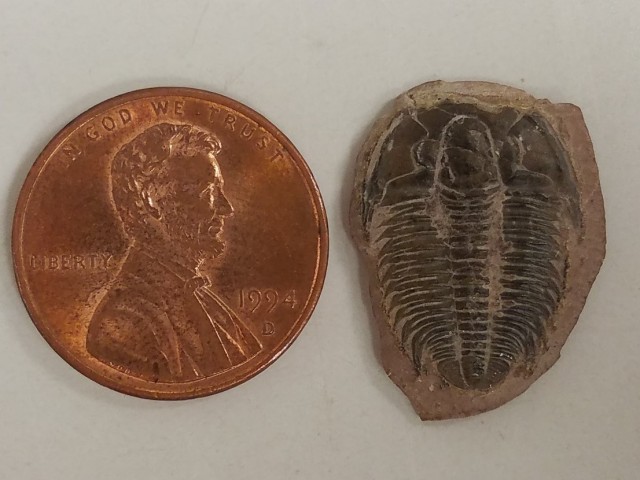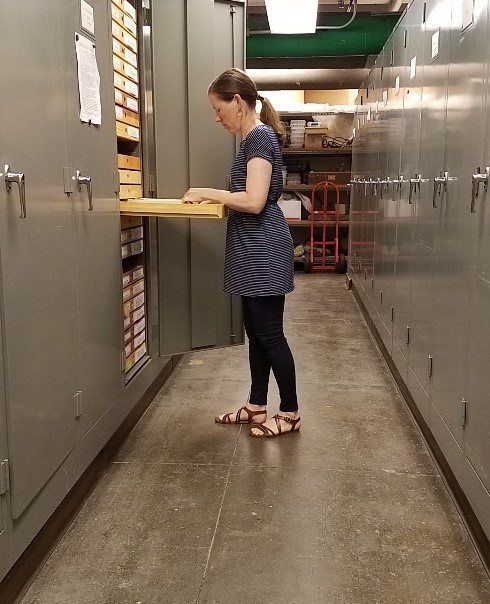by Suzanne Mills
“May it be a light to you in dark places, when all other lights go out.” ― J.R.R. Tolkien, The Fellowship of the Ring
“Elrathia kingi,” the small square of paper declares. Regal yet a bit mysterious, the Latin name on the museum-issue label conjures Tolkien. From an unlidded box small enough to hold a wedding ring, I remove a chalky gray pebble. Its minute weight slides easily through my fingers; it seems as inconsequential as a penny. But it is not hard to see what gives this iota of stone its value. As if sculpted in bas-relief, a pair of tiny eyes peek out of a crescent-shaped head. Thin ridges of a segmented body, symmetrically paired about two fine center lines, taper to a tail. Each detail is delicately edged in violet. It is a fossil trilobite, an extinct relative of the horseshoe crab.

But she is a humble beauty who lives a secret life. She is found behind the scenes in the Section of Invertebrate Paleontology (IP). In the fluorescent-lit museum basement, Elrathia kingi idles quietly in a long drawer with dozens of equally elegant companions. It is just one of thousands of drawers shelved in rows upon rows of gray metal cabinets. The cabinets stand silently at attention, protecting their specimens from dust, light, and heat while awaiting further orders.
More than 800,000 fossil marine organisms call the IP lab home. Collected from all over the world, they range in age from several thousand to almost a billion years old. Four thousand of these specimens have been featured in over 400 peer-reviewed publications. But others have never been studied in detail and hold valuable “dark data,”¹ ² undocumented information useful for studies about extinction³ and climate change.⁴ These data are central to the future advance of the science of paleontology and geology.⁵

As a part-time Collection Assistant, I help bring this “dark data” to light. My main tools are a laptop and a microscope. When I examine a trilobite, or fossil “bug,” under the microscope, I look for characteristics that verify the biological classification, based on what is written on the fossil’s label. Further information recorded on the label about the geologic layer and location where it was found helps to validate the scientific value. I verify all this information in professional peer-reviewed publications. Finally, I enter the data I glean into a new digital database and develop charts and graphs to summarize it. This is the beginning of highlighting the IP collection’s “dark data.”
The task of bringing more than three-quarters of a million IP specimens to light is daunting. My colleagues and I bow our heads to that number and acknowledge that it is far more than a life’s work. But we persist, hoping to help the world see the value of Elrathia kingi and her ancient ocean companions, one fossil at a time.
Suzanne Mills is a Collection Assistant in the Section of Invertebrate Paleontology at Carnegie Museum of Natural History. Museum employees are encouraged to blog about their unique experiences and knowledge gained from working at the museum.
Citations:
1. California Academy of Sciences. 2018. Scientists quantify the vast and valuable finds stored on museum shelves: Quantifying “dark data” in fossil collections is a call to arms; heralds a digital revolution. ScienceDaily. https: /www.sciencedaily.com/releases/2018/09/180920102122.htm (accessed July 21, 2021)
2. Thiers, Barbara, John Bates, Andrew C, Bentley, Linda S, Ford, David Jennings, Anna K, Monfils, Jennifer M, Zaspel, James P, Collins, Manzour Hernando Hazbón, and Jyotsna L, Pandey. 2021. Implementing a Community Vision for the Future of Biodiversity Collections. BioScience, Volume 71, Issue 6, June. Pages 561–563. https://doi.org/10.1093/biosci/biab036 (accessed July 23, 2021)
3. Casey, M. M., E. E. Saupe, and B. S. Lieberman. 2021. The effects of geographic range size and abundance on extinction during a time of “sluggish” evolution. Paleobiology, 47:54-67.
4. Lawing, A. M. 2021. The geography of phylogenetic paleoecology: integrating data and methods to better understand biotic response to climate change. Paleobiology, 47:178-197.
5. The Unique role of the Curator in Palaeontology. Special Papers in Palaeontology, 22, 7-15.
Special thanks to Albert Kollar and Joann Wilson for their insightful comments.
Related Content
Ask a Scientist: What is a trilobite?
Carnegie Museum of Natural History Blog Citation Information
Blog author: Mills, SuzannePublication date: August 24, 2021
